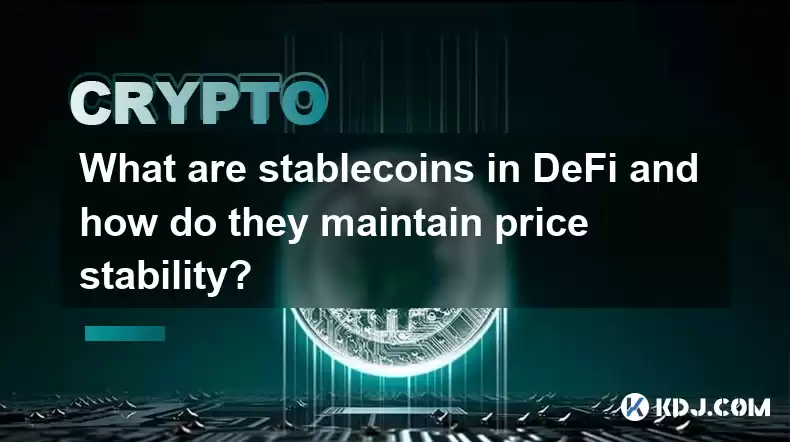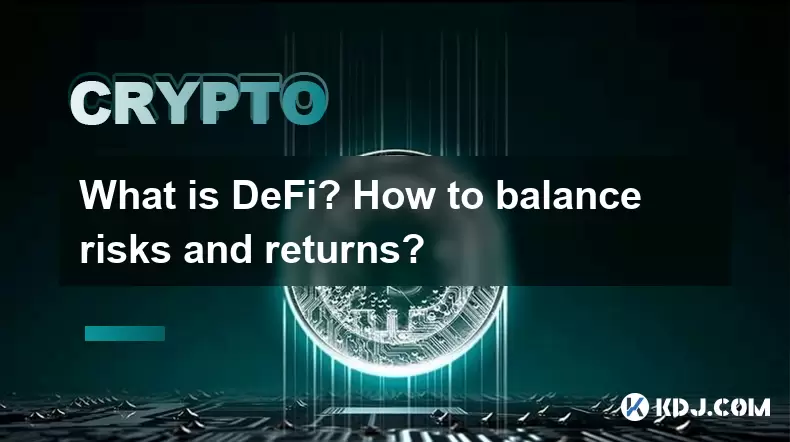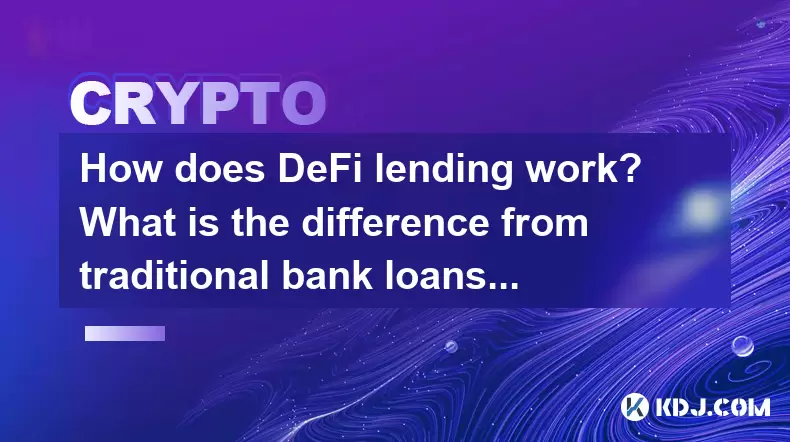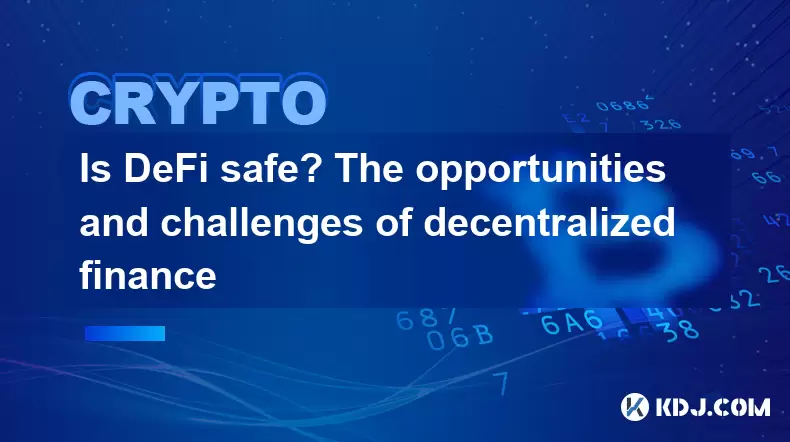-
 bitcoin
bitcoin $114779.865156 USD
2.30% -
 ethereum
ethereum $4226.519789 USD
2.39% -
 tether
tether $1.000545 USD
0.04% -
 xrp
xrp $2.890223 USD
0.92% -
 bnb
bnb $1030.029301 USD
2.95% -
 solana
solana $212.824944 USD
1.69% -
 usd-coin
usd-coin $0.999757 USD
0.01% -
 dogecoin
dogecoin $0.234961 USD
-0.27% -
 tron
tron $0.337174 USD
0.42% -
 cardano
cardano $0.804783 USD
0.09% -
 hyperliquid
hyperliquid $45.748770 USD
-2.85% -
 chainlink
chainlink $21.699170 USD
0.82% -
 ethena-usde
ethena-usde $1.001452 USD
0.08% -
 avalanche
avalanche $30.237800 USD
1.14% -
 stellar
stellar $0.372604 USD
1.52%
What are stablecoins in DeFi and how do they maintain price stability?
Stablecoins, crucial in DeFi, maintain value via various methods (collateralized, algorithmic, fiat-backed), each posing unique risks. Understanding these mechanisms is vital for safe DeFi participation.
Mar 15, 2025 at 02:41 pm

- Stablecoins are cryptocurrencies designed to maintain a stable value, typically pegged to a fiat currency like the US dollar.
- Several mechanisms exist to maintain this price stability, each with its own strengths and weaknesses.
- DeFi (Decentralized Finance) leverages stablecoins extensively for various applications, enhancing liquidity and reducing volatility.
- Understanding the different types and risks associated with stablecoins is crucial for navigating the DeFi landscape.
Stablecoins are a crucial component of the decentralized finance (DeFi) ecosystem. Unlike volatile cryptocurrencies like Bitcoin or Ethereum, stablecoins aim to maintain a consistent value, usually pegged to a national currency like the US dollar (USD), the Euro (EUR), or even a precious metal like gold. This stability is vital for facilitating transactions and reducing risk within DeFi applications. Without stablecoins, the volatility of other cryptocurrencies would make many DeFi activities impractical.
Mechanisms for Maintaining Price Stability:Several mechanisms are employed to maintain the pegged value of stablecoins. Understanding these is key to assessing the risks and benefits of each type.
- Collateralized Stablecoins: These stablecoins are backed by reserves of other assets, typically a mix of fiat currencies, cryptocurrencies, or other valuable assets. The ratio of collateral to issued stablecoins varies depending on the specific stablecoin. For example, a stablecoin might require $1.10 worth of collateral for every $1.00 of stablecoin issued, providing a buffer against price fluctuations. This method aims to ensure there are sufficient assets to redeem all issued stablecoins at the pegged value.
- Algorithmic Stablecoins: These stablecoins use algorithms and smart contracts to manage supply and demand, aiming to maintain their peg. These algorithms often involve minting and burning stablecoins based on market conditions. For example, if the price falls below the peg, the algorithm might burn stablecoins to reduce supply, increasing demand and potentially raising the price back to the peg. However, this mechanism is often complex and can be susceptible to unforeseen market events.
- Fiat-Collateralised Stablecoins: These stablecoins are backed 1:1 by fiat currency held in reserve accounts. This provides a relatively straightforward and secure mechanism for maintaining the peg. However, it requires trust in the entity holding and managing the reserves, and it may not be truly decentralized.
The use of stablecoins in DeFi is pervasive. Their price stability makes them ideal for various applications:
- Lending and Borrowing: Stablecoins are frequently used as collateral in decentralized lending platforms, allowing users to borrow other cryptocurrencies or stablecoins. The stable value reduces the risk of liquidation due to price swings.
- Trading and Exchange: Stablecoins provide a more stable trading pair for other cryptocurrencies, facilitating easier price discovery and reducing volatility in trading.
- Yield Farming: Many DeFi protocols offer yield farming opportunities with stablecoins, providing users with returns for lending or staking their stablecoins. However, it's essential to understand the associated risks before participating.
- Decentralized Exchanges (DEXs): Stablecoins are essential for providing liquidity and enabling efficient trading on decentralized exchanges. They act as a bridge between different cryptocurrencies, facilitating swaps and trades.
While stablecoins offer significant benefits, they also carry inherent risks:
- Collateral Risk: Collateralized stablecoins are vulnerable to the risk of the underlying collateral losing value. If the collateral's price falls significantly, it may not be sufficient to maintain the stablecoin's peg.
- Algorithmic Risk: Algorithmic stablecoins are complex and can be vulnerable to unforeseen market events or flaws in their algorithms, leading to instability and potential de-pegging.
- Custodial Risk: Fiat-collateralized stablecoins rely on the trust in the custodian holding the reserves. The possibility of fraud or mismanagement poses a significant risk.
- Regulatory Risk: The regulatory landscape surrounding stablecoins is still evolving, and changes in regulations could impact their operation and availability.
Q: Are all stablecoins created equal? A: No, stablecoins differ significantly in their mechanisms for maintaining price stability, each with its own associated risks and benefits. Some are collateralized, some algorithmic, and others fiat-backed. Understanding these differences is crucial before using them.
Q: How can I choose a safe stablecoin? A: There's no single "safest" stablecoin. Consider the backing mechanism (collateral type, algorithmic design, fiat reserves), the transparency of the reserves, the reputation of the issuer, and the regulatory landscape before investing in any stablecoin. Research thoroughly and diversify your holdings if you use stablecoins.
Q: What are the advantages of using stablecoins in DeFi? A: Stablecoins reduce volatility in DeFi applications, making them easier to use and reducing the risk of losses due to price fluctuations. They facilitate lending, borrowing, trading, and yield farming.
Q: Are stablecoins truly decentralized? A: The level of decentralization varies significantly across different stablecoins. Some are more centralized than others, particularly those relying on fiat reserves held by a single entity. Truly decentralized stablecoins are still under development.
Q: What happens if a stablecoin loses its peg? A: If a stablecoin loses its peg, its value will fluctuate, potentially leading to significant losses for users who hold it. The extent of the losses depends on the degree and duration of the de-pegging. It could render DeFi transactions using that stablecoin difficult or impossible.
Disclaimer:info@kdj.com
The information provided is not trading advice. kdj.com does not assume any responsibility for any investments made based on the information provided in this article. Cryptocurrencies are highly volatile and it is highly recommended that you invest with caution after thorough research!
If you believe that the content used on this website infringes your copyright, please contact us immediately (info@kdj.com) and we will delete it promptly.
- BlockDAG, DOGE, HYPE Sponsorship: Crypto Trends Shaping 2025
- 2025-10-01 00:25:13
- Deutsche Börse and Circle: A StableCoin Adoption Powerhouse in Europe
- 2025-10-01 00:25:13
- BlockDAG's Presale Buzz: Is It the Crypto to Watch in October 2025?
- 2025-10-01 00:30:13
- Bitcoin, Crypto, and IQ: When Genius Meets Digital Gold?
- 2025-10-01 00:30:13
- Stablecoins, American Innovation, and Wallet Tokens: The Next Frontier
- 2025-10-01 00:35:12
- NBU, Coins, and Crypto in Ukraine: A New Yorker's Take
- 2025-10-01 00:45:14
Related knowledge

How to track DeFi activity on a block explorer
Sep 04,2025 at 05:36pm
Bitcoin's Role in Decentralized Finance1. Bitcoin remains the cornerstone of the cryptocurrency ecosystem, serving as both a store of value and a benc...

What is the difference between DeFi and CeFi? An article analyzing the advantages and disadvantages of both
Jun 13,2025 at 03:57am
Understanding the Foundations of DeFi and CeFiTo fully grasp the difference between DeFi (Decentralized Finance) and CeFi (Centralized Finance), it’s ...

What is DeFi? How to balance risks and returns?
May 31,2025 at 12:22pm
What is DeFi? How to Balance Risks and Returns? Decentralized Finance, commonly known as DeFi, represents a revolutionary shift in the financial ecosy...

How does DeFi lending work? What is the difference from traditional bank loans?
May 29,2025 at 05:36pm
Introduction to DeFi LendingDeFi lending, or decentralized finance lending, represents a revolutionary shift in the way borrowing and lending are cond...

Is DeFi safe? The opportunities and challenges of decentralized finance
May 27,2025 at 02:28pm
Decentralized Finance, commonly known as DeFi, has revolutionized the financial landscape by offering a range of financial services without the need f...

DeFi Mining Tutorial: How to Maximize Profits and Reduce Risks?
May 27,2025 at 07:42am
DeFi, or Decentralized Finance, has opened up a new world of opportunities for crypto enthusiasts looking to maximize their profits through various mi...

How to track DeFi activity on a block explorer
Sep 04,2025 at 05:36pm
Bitcoin's Role in Decentralized Finance1. Bitcoin remains the cornerstone of the cryptocurrency ecosystem, serving as both a store of value and a benc...

What is the difference between DeFi and CeFi? An article analyzing the advantages and disadvantages of both
Jun 13,2025 at 03:57am
Understanding the Foundations of DeFi and CeFiTo fully grasp the difference between DeFi (Decentralized Finance) and CeFi (Centralized Finance), it’s ...

What is DeFi? How to balance risks and returns?
May 31,2025 at 12:22pm
What is DeFi? How to Balance Risks and Returns? Decentralized Finance, commonly known as DeFi, represents a revolutionary shift in the financial ecosy...

How does DeFi lending work? What is the difference from traditional bank loans?
May 29,2025 at 05:36pm
Introduction to DeFi LendingDeFi lending, or decentralized finance lending, represents a revolutionary shift in the way borrowing and lending are cond...

Is DeFi safe? The opportunities and challenges of decentralized finance
May 27,2025 at 02:28pm
Decentralized Finance, commonly known as DeFi, has revolutionized the financial landscape by offering a range of financial services without the need f...

DeFi Mining Tutorial: How to Maximize Profits and Reduce Risks?
May 27,2025 at 07:42am
DeFi, or Decentralized Finance, has opened up a new world of opportunities for crypto enthusiasts looking to maximize their profits through various mi...
See all articles










































































